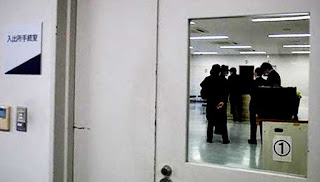 |
| Fukushima residents protests end of evacuee subsidies |
Saturday will mark six years since the 2011 Tohoku Earthquake and Tsunami. It marks as well the Fukushima Nuclear Disaster which caused the evacuation of over 150,000 residents of not only Fukushima City, but Fukushima Prefecture residents also.
At the end of this month, housing subsidies run out for those who fled the
Fukushima nuclear disaster from areas other than the
government-designated evacuation zones, and as the clock ticks down,
evacuees have had to decide whether to return or move once again.
Many of these so-called voluntary evacuees are mothers seeking to
avoid risking their children’s health while their husbands remain in
radiation-hit Fukushima Prefecture, according to freelance journalist
Chia Yoshida.
This is why the term “voluntary evacuee” is misleading, as it gives
the impression that they fled Fukushima for selfish reasons, Yoshida
told a news conference in January in Tokyo.
At the same news conference, another journalist proposed using the term “domestic refugee” to describe them.
The Fukushima Prefectural Government has been paying the cost of
public and private housing for voluntary evacuees under the Disaster
Relief Act since the reactors melted down at the Fukushima No. 1 nuclear
plant after the March 2011 earthquake and tsunami.
The number of evacuees from the disaster, including those from
mandatory evacuation areas, peaked at 164,865 as of May 2012, according
to the prefectural government.
Its latest tally, conducted earlier this year, shows that 11,321 out
of the 12,239 voluntary evacuee households had already decided where to
live after April, while 250 had not.
It was back in June 2015 when Fukushima announced the plan to end the
rent subsidy this month, saying that decontamination work in the
prefecture had advanced and food safety had been achieved.
Still, the central government’s evacuation orders have not been
lifted in “difficult-to-return zones,” which include the towns of Futaba
and Okuma, home to the crippled nuclear facility.
Those no-entry areas are subject to radiation of over 50
millisieverts per year, compared with the government’s long-term annual
target of less than 1 millisievert after decontamination work.
Rika Mashiko, 46, is a voluntary evacuee living in Tokyo. She has
decided to rent a house near the Fukushima-paid apartment where she and
her daughter, now in elementary school, are currently living so that her
daughter will not miss her friends.
Mashiko and her daughter fled Fukushima about two months after the
nuclear crisis started, leaving behind her husband in their house in
Miharu, located in the center of the prefecture.
Mashiko said many women evacuated from Fukushima with their children, compelled by their instinct as mothers to avoid danger.
“Maybe nothing might have happened, but if it had, it would have been too late,” she said.
Mashiko, who first moved to a house in Higashiyamato in eastern Tokyo
that was leased for free, said mothers like her who fled the nuclear
disaster feel they shouldn’t have to pay their housing costs and are
angry at being “victims of the state’s nuclear policy.”
Many voluntary evacuees are financially struggling as they have to
cover the double living costs in their hometowns, where typically the
fathers remain, and the new places where the mothers and children moved.
In that sense, the free housing has been a “lifeline” for them,
particularly in the Tokyo metropolitan area where housing costs are
high, according to journalist Yoshida.
In an attempt to extend support to those families, Makoto Yamada, a
veteran pediatrician in Tokyo, established a fund with ¥3 million out of
his own pocket to help them rent new houses, for example by covering
the deposit.
The initiative was the latest example of the support he has been
providing to evacuees. Three months after the disaster, he held a
counseling session in the city of Fukushima that attracted some 400
people concerned about radiation exposure. He has continued to hold
similar sessions in Tokyo.
Yamada, 75, says poor understanding of the plight of voluntary
evacuees has also played a role in bullying cases involving evacuee
children that have been reported across Japan since last year.
In one high-profile case, a first-year junior high school student in
Yokohama was called a “germ” at school, in reference to his supposed
exposure to radiation.
Society appears to generally feel that voluntary evacuees have
received a lot of money on top of the one-time compensation payment made
by Tokyo Electric Power Company Holdings Inc., the operator of
Fukushima No. 1.
Yamada says if people understood that voluntary evacuees had no wish
to leave but felt they had to, such bullying would disappear.
The first financial support from Yamada’s fund went to 10 mothers and
their children on Jan. 15. He was surprised to see the recipients shed
tears of joy upon receiving ¥200,000 or ¥300,000 each.
Yamada said the government has tried to reduce the number of evacuees
from Fukushima in order to claim that their ranks have decreased and
that the disaster has been overcome.
Yoshida echoed that view, describing the voluntary evacuees as
“people who will be eliminated from history as the government seeks to
trivialize the damage from radiation contamination and say their
evacuation was unnecessary.”
As long as there are evacuees living outside Fukushima, they will
remain a symbol showing the situation has yet to be solved, Yamada said.
“If you say ‘we will not forget about Fukushima,’ you should never
forget the terror of radiation, bearing in mind that people will not
live in safety as long as nuclear plants exist in the world,” he said.
“So, I want to continue to think about the evacuees.”
Kyodo







